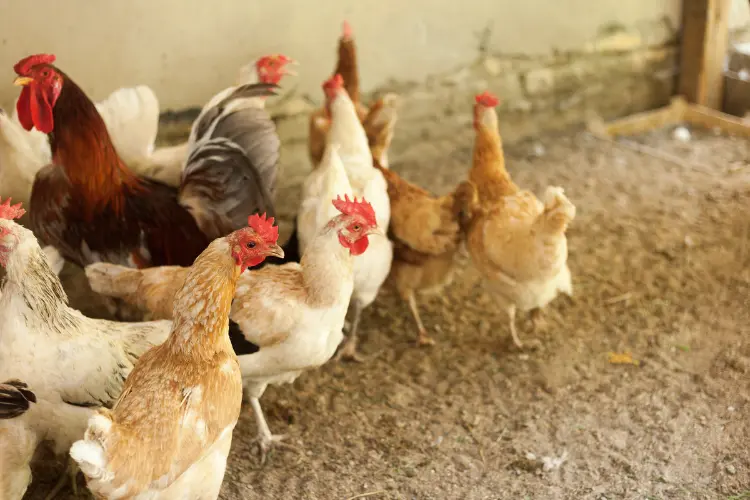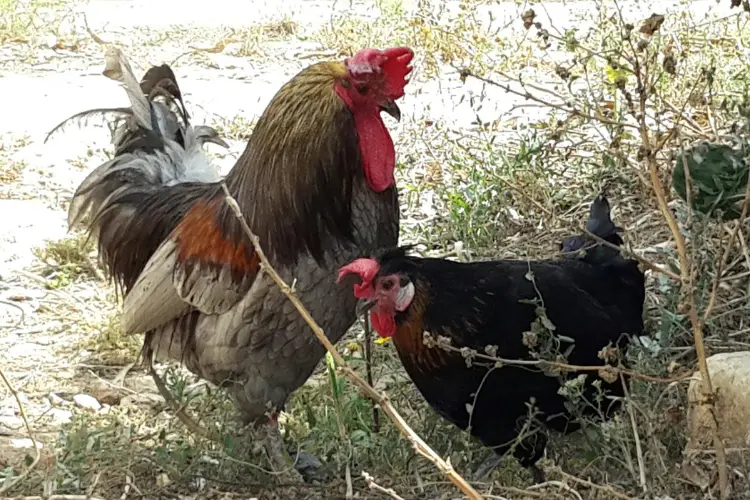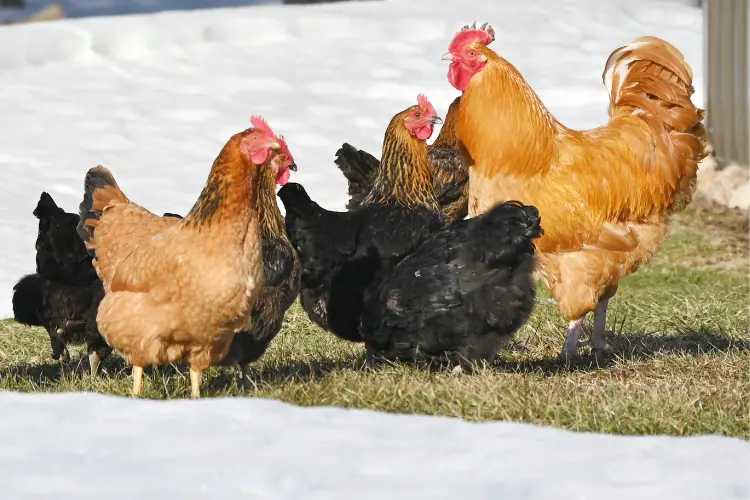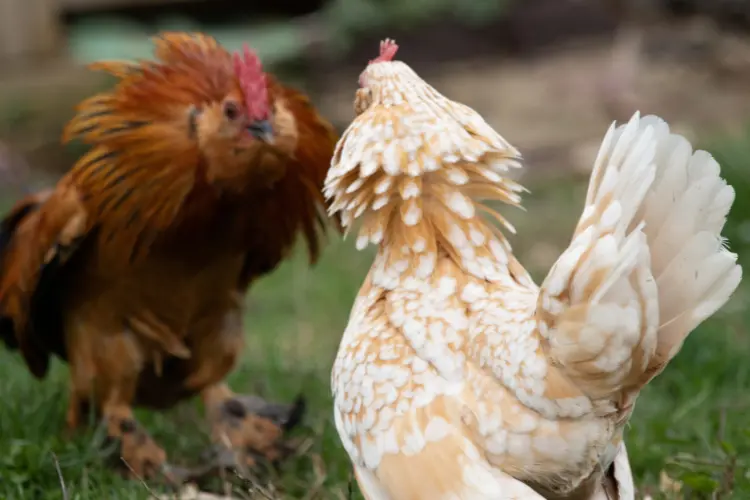How Many Hens Per Rooster: The Numbers You Need to Know
As a poultry farmer, you know that achieving the perfect balance in your flock isn’t as simple as adding more hens to the mix. Misjudging the correct ratio of hens to roosters can lead to various problems, including decreased egg production, aggression, and general unrest within the flock.
If you’ve been struggling to decipher how many hens per rooster you need for optimal results, our guide will help clear your doubts and prevent potential losses in your poultry venture. Let’s solve this equation together for the health and happiness of your flock.
How Many Hens per Rooster?
On average, 7-13 hens per rooster. This ratio can ensure optimal fertile eggs and prevent overbreeding, leading to stress and harm to the hens. But the ideal number of hens per rooster largely depends on several factors, including the breed, size, and age of the chickens, as well as your specific goals for egg production or breeding.
However, if you’re dealing with smaller chicken breeds, the number of hens per rooster can be slightly lower. For example, smaller breeds like one Bantam Sebright and Silkie may require a ratio of 6-7 hens. On the other hand, giant chicken breeds like one Jersey Giant and Orpington may handle a ratio of 10-12 hens.
In addition, the age of your roosters is an important consideration. Older roosters tend to be less fertile, with a noticeable decrease in fertility after around 72 weeks of age. A younger rooster, or cockerel, is generally more active and effective at mating. Therefore, if you primarily use cockerels, you may need one rooster for every 6-7 hens.

Importance of an Optimal Rooster-to-Hen Ratio
Maintaining an optimal rooster-to-hen ratio ensures a healthy and productive flock. An imbalanced ratio can lead to many problems, from disrupted egg-laying and brooding processes to increased aggression and stress among your chickens.
More Roosters, Fewer Hens
A surplus of roosters can create several complications:
- Too many roosters can lead to frequent fights, as roosters are territorial and don’t tolerate other roosters within their flock.
- If you’re practicing free-range farming, excess roosters might leave your farm for neighboring ones due to competition.
- Over-mating can stress hens and lead to physical damage, making them appear ragged.
- Excessive roosters can prevent hens from caring for their newly hatched chicks and discourage broody hens from sitting on eggs.
Fewer Roosters, More Hens
A lack of roosters can also pose problems:
- In commercial farming, fewer roosters mean fewer matings, leading to fewer fertilized eggs.
- Males may attack females they perceive as vulnerable when these females move away from the dominant male to feed
- For poultry farmers whose business relies on producing fresh eggs and healthy chicks, having too few roosters can result in a significant business loss.
- A single rooster may struggle to manage a large flock of hens, affecting the overall harmony and productivity of the flock.

How Many Roosters Should I Keep?
The number of roosters you should keep depends on various factors, including the size of your flock, the breed of your chickens, and your specific goals for your poultry operation. Here few factors to consider:
Flock Size
- If you have a single flock, it is typically recommended to keep only one rooster. This helps maintain a sense of harmony and reduces the likelihood of aggressive behavior among roosters.
- If you have multiple flocks, you may consider keeping more than one rooster per flock. This allows each flock to have its dominant male and minimizes conflicts between roosters.
Breed Characteristics
Different chicken breeds have varying levels of tolerance for multiple roosters. Some breeds, especially those with a more docile temperament, can tolerate multiple roosters in a flock. In contrast, more aggressive or territorial breeds may require a lower ratio of roosters to hens to maintain harmony.
Breeding Goals
If your primary goal is breeding or maintaining a purebred line, you may need to keep a higher number of roosters to achieve genetic diversity and ensure the successful fertilization of eggs. However, if you are focused on egg production rather than breeding, fewer roosters may be sufficient.
Space Availability
The size of your coop and the amount of space available for your chickens also play a role in determining the number of roosters you can keep. Having adequate space helps minimize territorial disputes and allows each young rooster to establish its territory within the flock.

Process and Frequency of Mating in Chickens
Chickens mate through a process called cloacal contact. When a rooster is ready to mate, he will mount the hen by climbing onto her back. The rooster’s cloaca, a common opening for reproductive, digestive, and excretory functions, aligns with the hen’s cloaca during mating. This allows for the transfer of sperm from the rooster to the hen.
The frequency of mating can vary depending on several factors, including the behavior of the rooster and the receptiveness of the hens. During the breeding season, roosters may actively pursue mating opportunities and attempt to mate with hens multiple times throughout the day. However, the actual success of mating depends on various factors, such as the hierarchy within the flock and the behavior of other roosters.
It’s important to note that not all mating attempts are successful, as hens may not always be receptive or willing to mate. Additionally, the frequency of mating may decrease outside of the breeding season.
How to Introduce New Hens to the Chicken Coop
- Before introducing new hens, it’s important to quarantine them separately for about 2-4 weeks. This helps avoid spreading diseases and allows you to observe their health. During this time, monitor the new hens for any signs of illness or issues.
- Begin by allowing the existing flock and new hens to see each other without direct contact. Place the new hens in a separate but visible area within the coop, or use a wire mesh partition to separate them. This visual introduction helps the chickens become familiar with each other without the risk of physical harm.
- After the visual introduction, you can move on to supervised physical introductions. Open the partition or provide a designated space where the new hens can interact with the existing flock under your supervision. Monitor their behavior closely for any signs of aggression or bullying.
- To prevent competition and reduce aggression, ensure that there are multiple food and water sources available in different areas of the coop. This allows the new hens to access food and water without being dominated by the existing flock.
- During the initial integration period, keep a close eye on the chickens’ behavior. Be prepared to intervene if there are signs of excessive aggression or bullying. Watch for prolonged and intense pecking, chasing, or feather pulling, which may require further separation or adjustments.
- Over time, continue monitoring the interactions between the new hens and the existing flock. If aggression persists, you may need to separate the birds temporarily and repeat the gradual integration process. Some degree of pecking order establishment is normal, but it should not be excessively harmful or endanger the new hens.

Advantages of Keeping Roosters
Fertility and Breeding
Roosters play a crucial role in the reproductive cycle of chickens. Their presence ensures that fertilization occurs when all the hens lay eggs. If you plan to breed chickens and maintain a sustainable flock, a rooster is essential for successful breeding.
Protection and Vigilance
Roosters are known for their protective nature. They take on the responsibility of safeguarding the flock, alerting the laying hens to potential danger, and keeping a watchful eye for predators. Their territorial instincts and loud crowing serve as deterrents to potential threats.
Social Structure and Flock Dynamics
A head rooster helps establish a social hierarchy within the flock. They maintain order and structure among the chickens, ensuring harmony and minimizing conflicts. They also help establish pecking order and provide a sense of security to the hens.
Natural Alarm Clock
The crowing of a rooster at dawn is a natural alarm clock. It can be useful for those who prefer waking up early or living in rural areas. Roosters have a reliable internal clock, making them dependable timekeepers.
Natural Pest Control
Roosters actively forage for food and are excellent hunters. They help control pest populations, including insects, rodents, and snakes, by chasing them away or even catching and consuming them. This can be advantageous for maintaining a healthy and pest-free environment.
Aesthetics and Ornamental Value
Roosters are often admired for their vibrant plumage and elaborate displays. They can enhance the visual appeal of a flock, adding a touch of beauty to the overall landscape. Many people also appreciate the cultural and artistic significance associated with roosters.
Natural Fertilizer
Roosters contribute to the overall fertility of the soil. Their droppings, combined with the manure from chickens, can be used as a natural fertilizer for gardens and plants. This nutrient-rich waste can help improve soil quality and enhance plant growth.
Disadvantages of Keeping Roosters:
Noise
Roosters are notorious for their crowing, which can be loud and occur throughout the day, not just in the morning. This can be disruptive, especially in urban or suburban areas where neighbors may be sensitive to noise. It’s important to consider local regulations or restrictions on noise levels before keeping roosters.
Aggression
Roosters can exhibit aggressive behavior, particularly during breeding season or when they perceive a threat to the flock. Aggressive roosters may become territorial and attack humans, other animals, or even the hens. This aggression can pose a risk, especially if you have children or pets.

Space Requirements
Roosters require more space than hens due to their larger size and active nature. They need ample room for exercise and displaying their natural behaviors, such as dust bathing and roosting. Insufficient space can lead to stress, health problems, and increased aggression.
Compatibility Issues
Not all roosters get along well with other roosters or hens. If you have multiple roosters or plan to introduce new ones, they may fight for dominance or territory. This can disrupt the harmony within the flock and lead to injuries or even death if not properly managed.
Legal Restrictions
Some residential areas, homeowner associations, or local ordinances restrict keeping roosters. These regulations may be in place due to noise concerns, zoning restrictions, or to maintain a certain quality of life within the community.
Unpredictable Offspring
If you plan to breed chickens, the offspring of roosters and hens may have unpredictable traits. It can be challenging to control or predict the characteristics, such as breed, color, or temperament, of the resulting chicks. This may not be a concern if you are not focused on specific breeding goals.
Conclusion
The ideal hens-to-rooster ratio for most chicken breeds is around 7-13 hens per rooster. This hen-rooster ratio promotes efficient fertilization while minimizing stress and aggression among the flock. However, breed, space, and individual circumstances may influence the optimal ratio. In raising chickens, careful observation and adjustments are necessary to maintain a healthy and productive flock.




